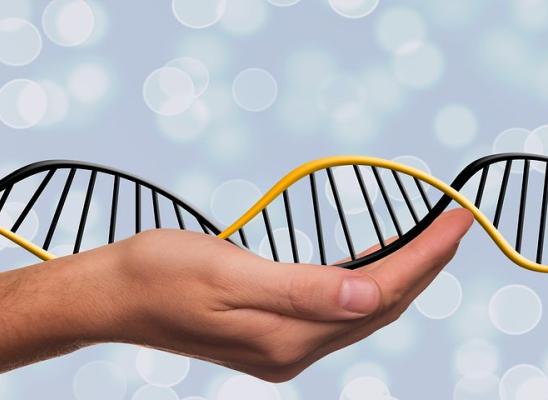Is Trichotillomania Genetic?

Online test
Find out the severity of your symptoms with this free online test
When inflicted with a debilitating condition such as trichotillomania, we yearn to understand why we are struggling with the behaviour, what causes it, and whether it can be prevented. It is also important to establish the cause of a condition when trying to find a cure or treatment that works. One of the major debates regarding the cause of trichotillomania is whether it is genetic.
What is "Genetic"?
First we need to understand what is meant by the term genetic. A condition is genetic when there is a biological basis for the condition. Our genes, which contain our DNA, are like maps of ourselves. Our genes determine what color hair we have, how tall we are, and other physical traits. They’re also responsible, to a degree, for our personalities, aptitude in different fields, emotional predilections, and other psychological factors. They can also make us prone to different diseases and conditions: due to mutations, or changes, in the make-up of our DNA, we can be more or less vulnerable to factors like heart disease and cancer. Being able to determine whether or not a condition is genetic can help identify people who are vulnerable to the condition in order to be more proactive in preventing onset or to be more aware of the signs and symptoms so that treatment can be accessed early on.
Trichotillomania and the Genetic Link
Trichotillomania is a condition that has a very murky background; no one is really sure what causes it, or why some people will develop it while others don’t. The condition, in which people feel an overwhelming desire to pull out their own hair, affects an estimated 1 in every 30 Americans. Without a clear idea of where the urge to pull hair comes from, understanding of the disease is limited; however, there is strong evidence that trichotillomania can be a genetic condition. Studies conducted at Duke University Medical Center showed some correlations between gene mutations and trichotillomania; two mutations in the SKITKR1 gene were shown to be shared by people suffering from the condition, though only a small percentage of the patients shared the mutations. Still, the existence of shared gene mutations among any of the trichotillomania cases gives credit to the theory that there is a biological factor involved in the condition. SKITKR1 is also correlated with Tourette’s syndrome, which is categorized as an Impulse Control Disorder. Prior to its reclassification in the fifth edition of the Diagnostic and Statistical Manual (DSM5) under Obsessive Compulsive and Related Disorders as a Body-Focussed Repetitve Behaviour (BFRB), trichotillomania was also considered an impulse control disorder. Though the study concluded that SKITKR1 mutations only accounted for about 5% of trichotillomania cases, it did find that having a family member with Tourette’s syndrome could be a risk factor for developing trichotillomania, and that family members without the mutation did not share the condition.
Genetic Influence on Behaviour
SKITKR1 is a gene associated with neuron connections; neurons, which are what we refer to as brain cells, connect to each other like wires in a television, communicating information and feed back via electricity. How our neurons connect is responsible for essentially all of our actions, from the most basic life-sustaining processes like digestion to more complex processes like higher thinking and emotion. The two mutations found responsible for some trichotillomania cases were theorized to create “faulty wiring” which creates the desire to pull out hair. It is likely that there are a number of genes that are involved in trichotillomania; and while SKITKR1 was the first gene studied extensively enough to provide any concrete correlation, there is reason to believe that the way SKITKR1 interacts with other genes can help to trigger the condition.
Twin Studies
Further evidence that trichotillomania is a genetic condition comes from a study that analyzed twins; out of 34 twins studied, 38.1% of monozygotic twins were shown to have the condition, versus 0% of dizygotic twins. Monozygotic twins are colloquially known as “identical twins”: they are the result of a single egg splitting in two after fertilization, which means that they are genetically identical. Dizygotic twins are the result of two different eggs being fertilized at the same time, giving them completely independent genetic maps.
Will my children inherit it?
Just because there is evidence of trichotillomania having a genetic basis does not necessarily mean that someone with trichotillomania will pass the condition along to their children. In a 1994 study, only about 5% of the trichotillomania patients had a first-degree relative who shared the disease. Not all mutations are passed on, and because there are two DNA strands that come together at conception, it is not absolutely certain that a parent with the SKITKR1 mutations will pass those along to their children.
If not Genetics, then what?
However, if only about 5% of patients have the genetic mutation linked to trichotillomania, what is the cause in other patients? One of the most closely linked conditions to trichotillomania is Obsessive Compulsive Disorder (or OCD), and there is also a high comorbidity with other mental conditions such as anxiety disorder and depression. The inclusion of trichotillomania in the DSM5, saw its reclassification from an impulse control disorder to an Obsessive Compulsive and Related Disorder. Individuals with OCD engage in repeated, ritualistic actions as a way of coping with negative, obsessive thoughts that cause considerable emotional distress. The obsessive thoughts are often fears of harming oneself or others, as well as fear of dirtiness, sex, death, or numerous other concepts. The ritualistic behavior is believed, by the sufferer, to prevent the fears from becoming reality. Trichotillomania is heavily associated with OCD because it often appears alongside OCD or as part of OCD, and because they both tend to occur in the same families. Furthermore, OCD medication has shown to be effective in treating trichotillomania, implying that they are closely connected. Regardless of the cause, it is clear that not everyone with a genetic predisposition, nor a known diagnosis of OCD pulls out their own hair; and conversely not everyone who suffers from trichotillomania necessarily suffers from OCD or has familial history of compulsive hair pulling.
The obsessive thoughts are often fears of harming oneself or others, as well as fear of dirtiness, sex, death, or numerous other concepts. The ritualistic behavior is believed, by the sufferer, to prevent the fears from becoming reality. Trichotillomania is heavily associated with OCD because it often appears alongside OCD or as part of OCD, and because they both tend to occur in the same families. Furthermore, OCD medication has shown to be effective in treating trichotillomania, implying that they are closely connected. Regardless of the cause, it is clear that not everyone with a genetic predisposition, nor a known diagnosis of OCD pulls out their own hair; and conversely not everyone who suffers from trichotillomania necessarily suffers from OCD or has familial history of compulsive hair pulling.
Online test
Find out the severity of your symptoms with this free online test
Start your journey with TrichStop
Take control of your life and find freedom from hair pulling through professional therapy and evidence-based behavioral techniques.
Start Now



